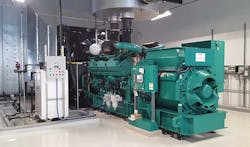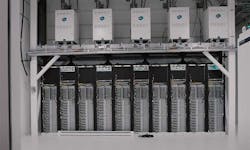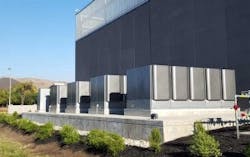Microsoft plans to eliminate its reliance on diesel fuel by the year 2030 as part of its goal to be carbon negative, the company said this week. The announcement has major implications for the company’s data centers, many of which use diesel-powered generators for emergency backup power.
Microsoft has been working for years to develop effective alternatives to the use of diesel generators, citing the need to make its data centers more sustainable and less reliant on the utility grid. but continues to install large numbers of generators at new data centers. With its new deadline, Microsoft sets in motion a push to either replace its generators with cleaner technologies, or perhaps eliminate them altogether by managing resiliency through software.
“Today, we’re announcing that we’re aiming to eliminate our dependency on diesel fuel by 2030,” Microsoft Chief Environmental Officer Lucas Joppa wrote in a blog post Tuesday. “While diesel fuel accounts for less than 1% of our overall emissions, we believe it’s important to help accelerate the global transition away from fossil fuels. We’re charting a new course using low-carbon fuel sources, including hydrogen and energy storage.”
Microsoft Azure is one of the largest cloud computing platforms, with infrastructure in 53 regions around the world. The company has also been a leading customer of data center developers, leasing hundreds of megawatts of capacity from companies that provide wholesale data center space.
It’s early to say how Microsoft may approach its presence in third-party sites that operate diesel generators. But it’s likely that developers will begin focusing more intently on alternatives to generators, either as a retrofit option or a strategy to capture future business from Microsoft.
Making Generators Obsolete
Microsoft first announced its interest in reducing its use of generators in 2012. Since then, it has tested several alternative approaches.
- In 2014, Microsoft outlined plans to power portions of its facility in Cheyenne, Wyoming with biogas waste from a water treatment plant.
- In 2017, the company created an Advanced Energy Lab in Seattle that powered 20 racks of servers with fuel cells powered by natural gas, teaming with McKinstry and Cummins on the project.
It’s not clear that Microsoft has deployed any of these technologies at the kind of scale that could replace the global fleet of diesel generators supporting its server farms. In recent construction projects, the company has continued to install large numbers of diesel generators.
An example: Early this year, Microsoft applied for permits to add five new diesel generators at its new Columbia C06 data center, which would give it 40 diesel engines at the facility, the most recent addition to its campus in Quincy, Washington.
Above-rack fuel cells supporting servers at the Microsoft Advanced Energy Lab in Seattle. (Image: Microsoft)
Microsoft acknowledged that there is much work ahead to realize its ambition.
“We recognize the challenges this might entail and that we need help in developing a robust supply chain for these fuels and advancements in battery technology,” Joppa noted, adding that Microsoft is “ready to work with partners across the world while leveraging investments from our Climate Innovation Fund to make this a reality.”
Generators: Hard to Love, Hard to Leave
The data center industry was created to ensure that mission-critical applications never go offline. That goal has typically been achieved through layers of redundant electrical infrastructure, including uninterruptible power supply (UPS) systems and emergency backup generators.
Eliminating expensive generators and UPS systems has been a goal for some hyperscale providers. In 2010, Yahoo began exploring using power backup for only a portion of its workloads, primarily for networking. Facebook chose Lulea, Sweden for a data center because the robust local power grid allowed it to operate with fewer generators. In the U.S., providers have experimented with “data stations” that operate with no generators on highly-reliable locations on the power grid.
“Almost every operator and owner would like to eliminate generators and replace them with a more modern, cleaner technology,” Andy Lawrence of the Uptime Institute noted in a blog post. “But to date, no other technology so effectively combines low operating costs, energy density, reliability, local control and, as long as fuel can be delivered, open-ended continuous power … Few – very few – can even contemplate operating production environments without diesel generators.”
These Bloom Energy Server fuel cells are using biogas to provide 1 megawatt of power to the Equinix SV 5 data center in San Jose. (Photo: Rich Miller)
Lawrence noted four options companies have pursued as alternatives to generators – fuel cells, lithium-ion batteries, shifting capacity to smaller edge data centers that can more easily run on batteries, and shifting to cloud-based resiliency.
On the fuel cell front, colocation giant Equinix has installed about 40 megawatts of Bloom Energy Server capacity in 12 data centers in California, New York and Los Angeles. The Bloom Energy Server uses solid oxide fuel cell technology that converts fuel to electricity through an electro-chemical reaction, without any combustion. It can work with either natural gas or biofuels, such as biogas from landfills.
At DCF, we’ve written about the growing trend to manage resiliency through the network, as well as multi-tenant data centers’ increased use of variable resiliency – housing some workloads with no generator or UPS support – as a means of reducing the need for redundant infrastructure (and the accompanying expense). Since 2016, we’ve tracked how versions of this trend have been implemented at providers like Verne Global, Vantage Data Centers, Digital Realty (DFT), Sentinel Data Centers and CyrusOne.
Much of recent thinking about resiliency has been influenced by the use of availability zones (AZs) by cloud platforms, especially Amazon Web Services. AZs are clusters of data centers within a region that allow customers to run instances of an application in several isolated locations to avoid a single point of failure. If customers distribute instances and data across multiple AZs and one instance fails, the application can be designed so that an instance in another availability zone can handle requests.
About the Author





